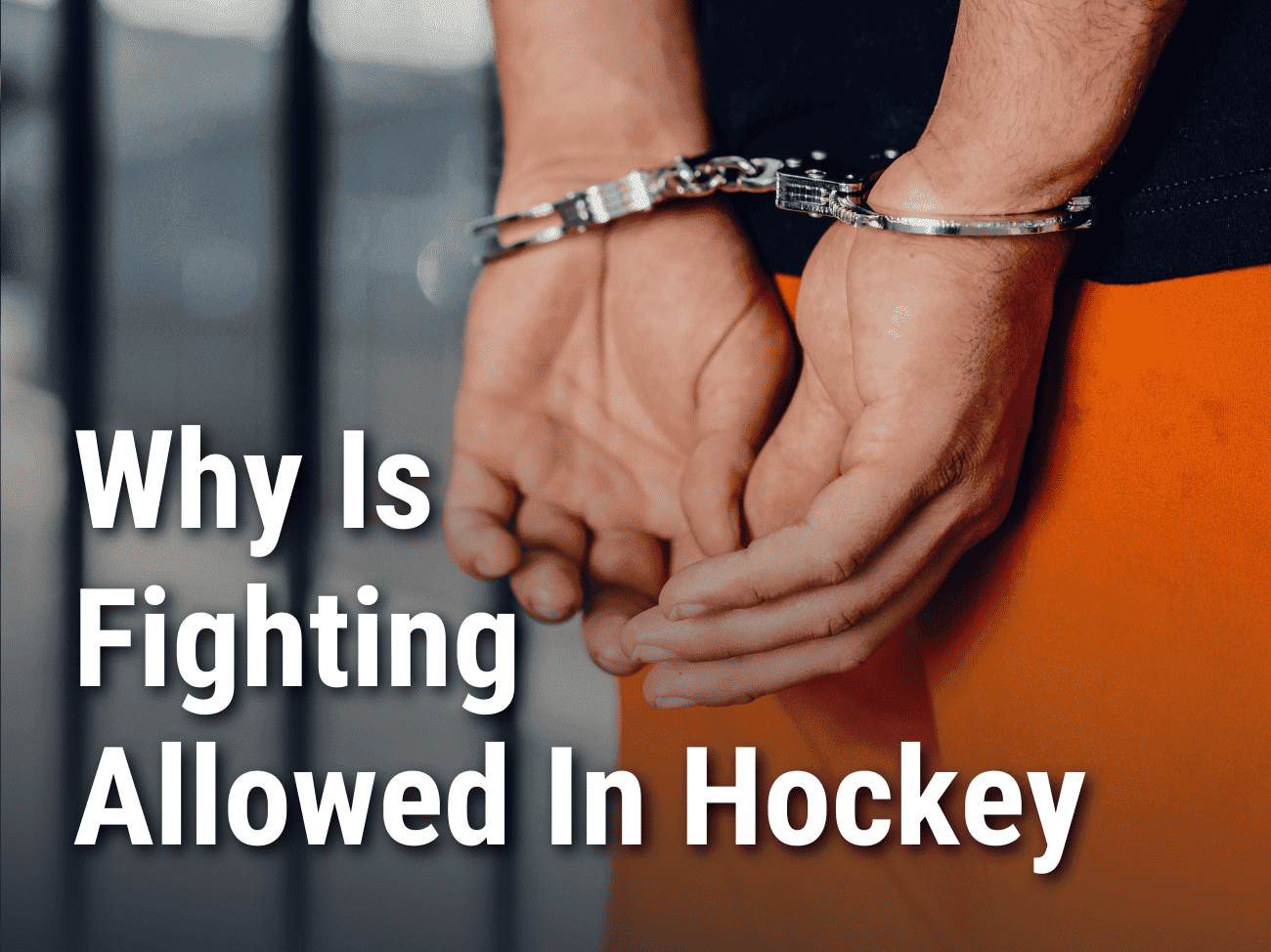Hockey is a sport renowned for its speed, physicality, and intense rivalries. It captivates audiences worldwide with its combination of skill, strategy, and raw emotion. One aspect of hockey that has been a subject of intrigue and debate is the allowance of fighting.
Why is fighting allowed in hockey?
“Tradition” is the reason why fighting is allowed in hockey. Fighting has been an integral part of the sport from the very beginning. For the NHL, all fighting rules are outlined under Rule 64 of the Official NHL Rulebook.
Why Is Fighting Allowed In Hockey
Technically fighting is not allowed in hockey – it is a penalty.
However, the repercussions are pretty light compared to other sports. Most normal fights in hockey will result in nothing more than a 5 min penalty. After the penalty is served the players return to the game and it’s business as usual.
As to why fighting continues to stay in hockey, it can be attributed to three things:
- Tradition
- Fan Approval
- Self-policing

Tradition Makes Fighting Allowed In Hockey
Asking why fighting is allowed in hockey is like asking why dunks are allowed in basketball, or why home runs are allowed in baseball – it’s just a part of the sport.
Fighting in hockey has been around since organized hockey has been around. It can be traced back to the early days of the sport, when hockey emerged as a rough-and-tumble game played on frozen ponds, physical altercations were an accepted and even expected part of the game.
The roots of fighting in hockey can be attributed to the sport’s gritty heritage, harking back to a time when players defended their teammates and settled disputes with their fists. Without fighting, hockey wouldn’t be the same.
Fan Approval Makes Fighting Allowed In Hockey
Fans love fights.

There are few moments as exciting in hockey as when two players drop their gloves. When a fight unfolds, every single fan is out of their seat and the arena explodes with noise. Fights are all-captivating spectacles within hockey.
Very few fans would want to remove one of the most exciting aspects of the sport.
Self-Policing Benefits Make Fighting Allowed In Hockey
Fighting in hockey can act as a form of self-policing by creating a deterrent against excessive physicality, dangerous plays, and unsportsmanlike behavior. Here’s how it works:
- Deterrence
- The presence of fighting establishes a deterrent effect on players. Knowing that their actions may result in a physical confrontation and potential repercussions, players are more likely to think twice before engaging in dangerous or malicious acts. The fear of facing a willing combatant and the potential physical consequences can discourage players from crossing the line and engaging in behavior that could harm opponents.
- Protection of Skilled Players
- In hockey, there are often players who possess exceptional skill and playmaking abilities. These players are valuable assets to their teams and may become targets of rough play or cheap shots from opponents seeking to neutralize their effectiveness. Enforcers or players designated as “protectors” step in to defend their skilled teammates and deter opponents from targeting them. By engaging in fights, these enforcers create a disincentive for opponents to engage in overly aggressive tactics against star players, as they know they will face consequences on the ice.
- Establishing a Code of Conduct
- Fights can help establish a code of conduct within the game. Players understand that there are boundaries and consequences for certain actions. Engaging in a fight, while not condoned in terms of the rules, can serve as a means of asserting these boundaries. It becomes a visible display of a player standing up for themselves, their teammates, or the integrity of the game, reinforcing the idea that there are limits to what is acceptable behavior on the ice.
- Team Unity and Support
- Fighting can foster a sense of unity and support within a team. When a player engages in a fight to protect a teammate or defend team honor, it sends a message of solidarity and loyalty. This unity can create a cohesive bond among players, contributing to a strong team culture that promotes fair play, respect, and self-regulation.
A good example of the self-policing that fighting provides in hockey is the protection of goaltenders. Goalies are usually very well-protected in hockey. Any player who hits or punches a goalie will 100% have someone’s fist in their face, so most players will avoid touching the goalie.
The protection of goalies keeps them from getting injured, which is important because each team only has 2 goalies. If the goalies were to get hurt, the game is practically over.
When Did Hockey Players Start Fighting?
As mentioned tradition is mostly what makes fighting allowed in hockey.
The origins of fighting in hockey can be traced back to the early days of the sport in the late 19th and early 20th centuries. As hockey evolved from its informal outdoor origins to organized leagues, physical altercations were not uncommon and were considered a part of the game.

One of the reasons for fighting in early hockey was the lack of strict rules and regulations regarding player conduct. The sport was played on frozen ponds and later in indoor rinks, and the rough and tumble nature of the game often led to physical confrontations between players.
Fighting served various purposes, including settling disputes, defending teammates, and asserting dominance. It was seen as a way to establish boundaries and deter opponents from taking advantage or engaging in unsportsmanlike behavior.
Over time, fighting became ingrained in the culture of the sport, particularly in North American hockey. The acceptance of fighting in hockey can be attributed to its historical development, the influence of physical enforcers, and the tradition that has been passed down through generations of players.

It’s important to note that the tolerance and regulations surrounding fighting have changed over the years. Leagues, such as the National Hockey League (NHL), have implemented rules and penalties to regulate fighting and improve player safety. The ongoing debate surrounding fighting in hockey continues to shape the sport, and its future remains subject to further discussion and potential changes.
Why Is Fighting In Hockey Not A Crime?
Fighting is not a crime in hockey for the same reason that fighting is not a crime in boxing – it’s part of the sport. The rules make fighting allowed in hockey. However, there are equal rules that outline ways of fighting that are not allowed in hockey. In some cases, if a player were to break those rules, their actions can be considered criminal.
It is not often, but it has happened in the NHL where a player has received criminal charges for their on-ice conduct. One of the most famous examples of this is the 2004, Todd Bertuzzi-Steve Moore incident.
The incident took place as retaliation for an earlier incident in which Moore had delivered a controversial hit on Canucks captain Markus Naslund. Seeking retribution, Bertuzzi skated up to Moore from behind, grabbed the back of his jersey, and sucker-punched him in the side of the head. Moore fell face-first onto the ice, suffering severe injuries, including three fractured vertebrae in his neck, a concussion, and various cuts and bruises.

Thankfully, Moore was not paralyzed in the incident, but he was never able to play professionally again.
The incident had significant repercussions, both legally and within the NHL. Bertuzzi was initially suspended indefinitely, and later the suspension was upheld for the rest of the season, playoffs included. He also faced criminal charges, eventually pleading guilty to assault causing bodily harm and receiving a conditional discharge.
The incident sparked a widespread debate about violence and player safety in hockey. It led to the implementation of rule changes aimed at reducing dangerous play and targeting players from behind. The incident also resulted in legal proceedings, with Moore filing a civil lawsuit against Bertuzzi and the Canucks, which was eventually settled out of court in 2014.
The Bertuzzi incident serves as a prominent example of the consequences of on-ice violence and the ongoing discussions surrounding player safety and the role of fighting in the NHL.


Leave a Reply